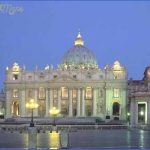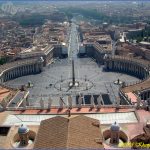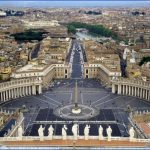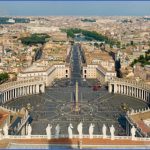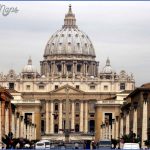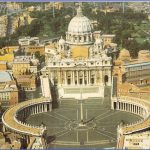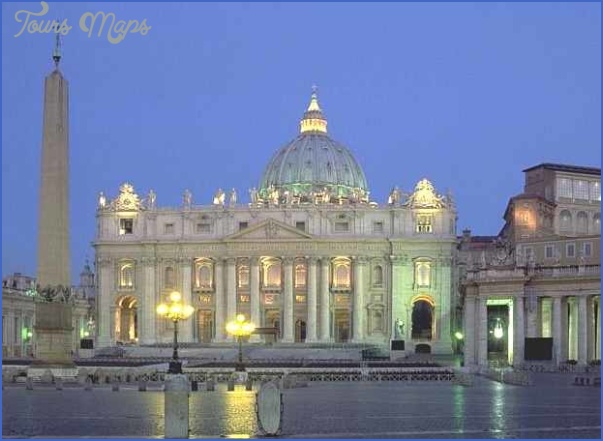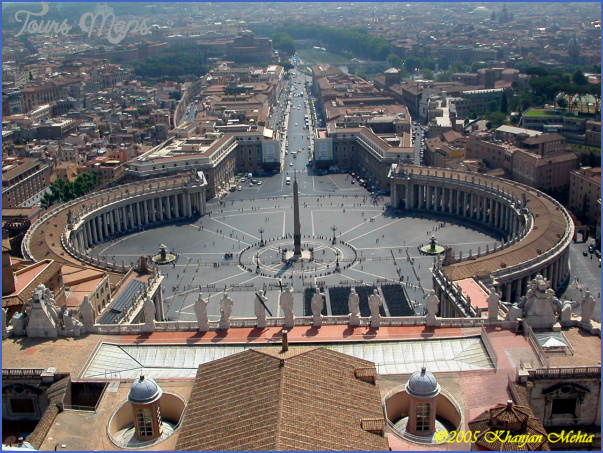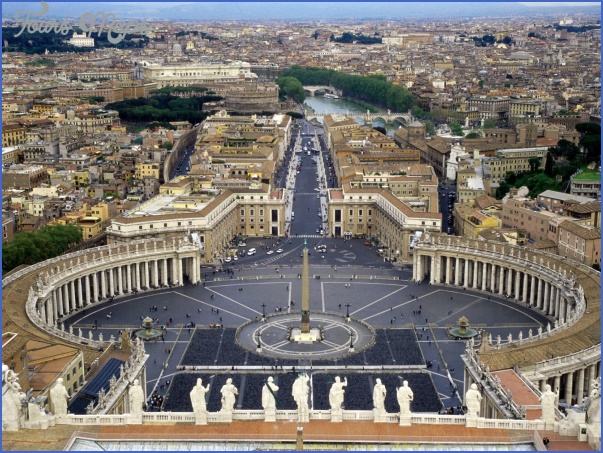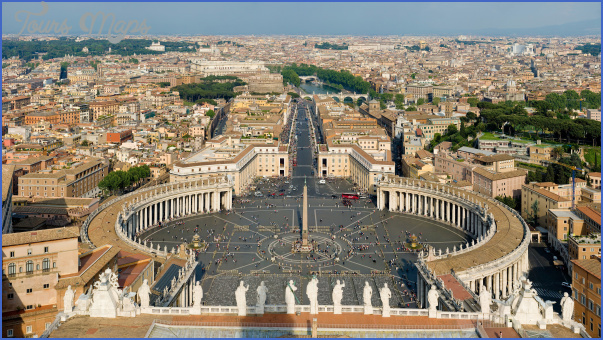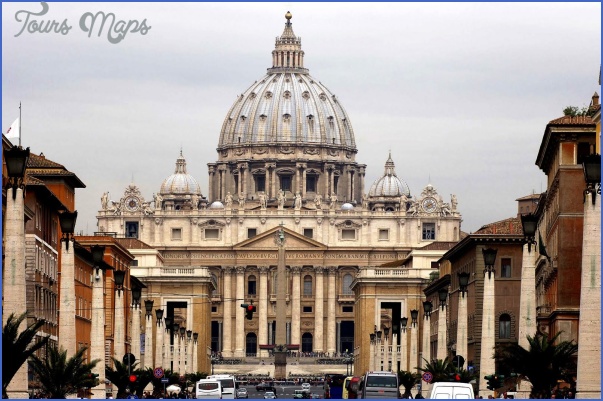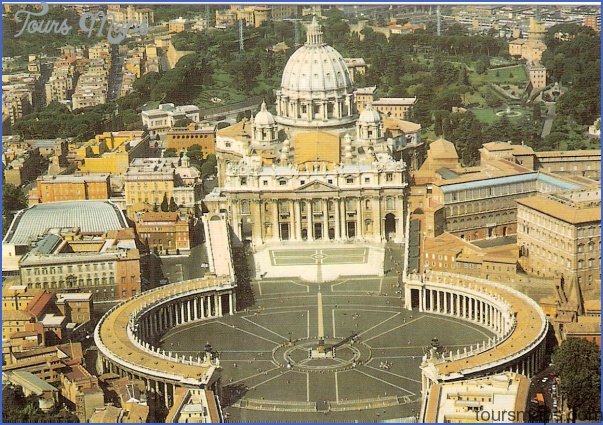THE VATICAN CITY
The Vatican City is the seat of the Catholic Church and was once the mightiest power in Europe. The nation preserves its independence by running a separate postal system and maintaining an army of Swiss Guards. (M: A-Ottaviano orA-Cipro Musei Vaticani. Alternatively, catch bus #64 or 492 from Termini or Largo Argentina, 62 from P. Barberini, or 23 from Testaccio. 06 69 82.)
BASILICA DI SAN PIETRO (ST. PETER’S). A colonnade by Bernini leads from Piazza San Pietro to the church. The obelisk in the center is framed by two fountains; stand on the round discs set in the pavement and the quadruple rows of the colonnade will visually resolve into one perfectly aligned row, courtesy of the Reformation popes’ battery of architects. Above the colonnade are 140 statues; those on the basilica represent Christ, John the Baptist, and the Apostles (except for Peter, naturally). The pope opens the Porta Sancta (Holy Door) every 25 years by knocking in the bricks with a silver hammer; the last opening was in 2000, so don’t hold your breath. The basilica itself rests on the reputed site of St. Peter’s tomb. To the right, Michelangelo’s Pietd has been protected by bulletproof glass since 1972, when an axe-wielding fiend smashed Christ’s nose and broke Mary’s hand. Arnolfo di Cambio’s Peter, in the central nave of the basilica, was not originally malformed, but centuries’ worth of pilgrims rubbing his foot have crippled him. The climb to the top of the Dome might very well be worth the heart attack it will undoubtedly cause. An elevator will take you up about 300 of the 330 stairs. (Dress modestly-no shorts, skirts above the knee, sleeveless shirts, or sundresses allowed. Multilingual confession available. Open daily 7am-7pm. Mass M-Sa 9, 10, 11am, noon, and 5pm; Su 9,10:30,11:30am, 12:10,1, 4, and 5:30pm. Dome: From inside the basilica, exit the building, and reenter the door to the far left with your back to the basilica. ‚4, by elevator ‚5. Open Apr.-Sept. daily 7am-5:45pm; Oct.-Mar. 7am-4:45pm.)
IISISTINE CHAPEL. Ever since its completion in the 16th century, the Slstine Chapel (named for its founder, Pope Sixtus IV) has served as the chamber in which the College of Cardinals elects new popes. Michelangelo’s ceiling, at the pinnacle of artistic creation, gleams from its restoration. The simple compositions and vibrant colors hover above, each section depicting a story from Genesis. The scenes are framed by the famous ignudi (young nude males). Contrary to legend, Michelangelo did not paint flat on his back, but standing up and craning backward, and he never recovered from the strain to his neck and eyes. The Lost Judgement fills the altar wall. The figure of Christ as judge hovers in the upper center, surrounded by his saintly entourage and the supplicant Mary. Michelangelo painted himself as a flayed human skin that hangs symbolically between the realms of heaven and hell. The cycle was completed between 1481 and 1483 by a team of artists under Perugino including Botticelli, Ghirlandaio, Roselli, Pinturicchio, Signorelli, and della Gatta. The frescoes on the side walls predate Michelangelo’s ceiling; on the right, scenes from the life of Moses complement parallel scenes of Christ’s life on the left. (Admission included with Vatican Museums, 652.)
CASTEL SANT’ANGELO. Built by Hadrian (AD 117-138) as a mausoleum for himself and his family, this mass of brick and stone has served as a fortress, prison, and palace. When the city was wracked with the plague in 590, Pope Gregory the Great saw an angel sheathing his sword at the top of the complex; the plague abated soon after, and the edifice was rededicated to the angel. The fortress offers an incomparable view of Rome and the Vatican. Outside, the marble Ponte Sant’Angelo, lined with statues of angels designed by Bernini, is the starting point for the traditional pilgrimage route from St. Peter’s to the Church of San Giovanni in Laterano. (Walk along the river with St Peter’s behind you and the towering castle to your left; follow the signs to the entrance. Open Su and Tu-Sa 9am-7pm. ‚5.)
TRASTEVERE
Right off the Ponte Garibaldi stands the statue of the famous dialect poet G.G. Bellie. On V. di Santa Cecilia, behind the cars, through the gate, and beyond the courtyard full of roses is the Basilica di Santa Cecilia in Trastevere; Carlo Mad- erno’s famous statue of Santa Cecilia lies under the altar. (Open M-Sa 8am- 12:30pm and 4:15-6:30pm; Su 9:30-10am, ll:15-noon, and 4:15 :30pm.) From P. Son- nino, V. della Lungaretta leads west to P.S. Maria in Trastevere, home to numerous stray dogs, expatriates, and the Chiesa di Santa Maria in Trastevere, built in the 4th century. (Open M-Sa 9am-5:30pm, Su 8:30-10:30am and noon-5:30pm.) North of the piazza are the Rococo Galleria Corsini, V. della Lungara 10, and, across the street, the Villa Farnesina, the jewel of Trastevere. Atop the Giani- colo hill is the Chiesa di San Pietro in Montorlo, built on the spot once believed to be the site of St. Peter’s upside-down crucifixion. The church contains del Piombo’s Flagellation, from designs by Michelangelo. Next door in a small courtyard is Bramante’s tiny ilTempietto. A combination of Renaissance and ancient architecture, it was constructed to commemorate the site of Peter’s martyrdom and provided the inspiration for the larger dome of St. Peter’s. Rome’s botanical gardens contain a garden for the blind as well as a rose garden that holds the bush from which all the world’s roses are supposedly descended. (Church and Tempietto open daily 9:30am-12:30pm and 4-6pm.)
NEAR TERMINI
The sights in this urban part of town are concentrated northwest of the station and to the south, near P. V. Emanuele II.
PIAZZA DEL QUIRINALE AND VIA XX SETTEMBRE. Several blocks south of P. Barberini and northeast of P. Venezia, the statues of Castor and Pollux, Rome’s protectors, flank yet another obelisk that served as part of Sixtus V’s redecoration plan. The Chiesa di Sant’Andrea al Quirinale, full of Bernini’s characteristic jolly cherubs, highlights the artist’s ability to combine architecture and painting for a single, coherent effect even if that effect is as overdone as most Baroque work. (Open Sept.-July M and WSu 8am-noon and 4-7pm; Aug. M and W-Su 8am-noon.) A Counter- Reformation facade by Mademo marks Santa Susanna, the American parish in Rome. The Mannerist frescoes by Croce are worth a look. (Open daily 9am-noon and 4-7pm.)
BASILICA OF SANTA MARIA MAGGIORE. As one of the five churches in Rome granted extraterritoriality, this basilica, crowning the Esquiline Hill, is officially part of Vatican City. To the right of the altar, a marble slab marks the tomb of Bernini. The 14th-century mosaics in the loggia recount the story of the August snowfall that showed the pope where to build the church. (Dress code strictly enforced. Open daily 7am-7pm. Loggia open daily 9:30am-lpm. Tickets in souvenir shop ‚2.70.)
THE VATICAN CITY Photo Gallery
Maybe You Like Them Too
- Explore Nevestino, Bulgaria with this Detailed Map
- Explore Pulau Sebang Malaysia with this Detailed Map
- Explore Southgate, Michigan with this detailed map
- Explore Les Accates, France with this Detailed Map
- Explore Góra Kalwaria, Poland with this detailed map

